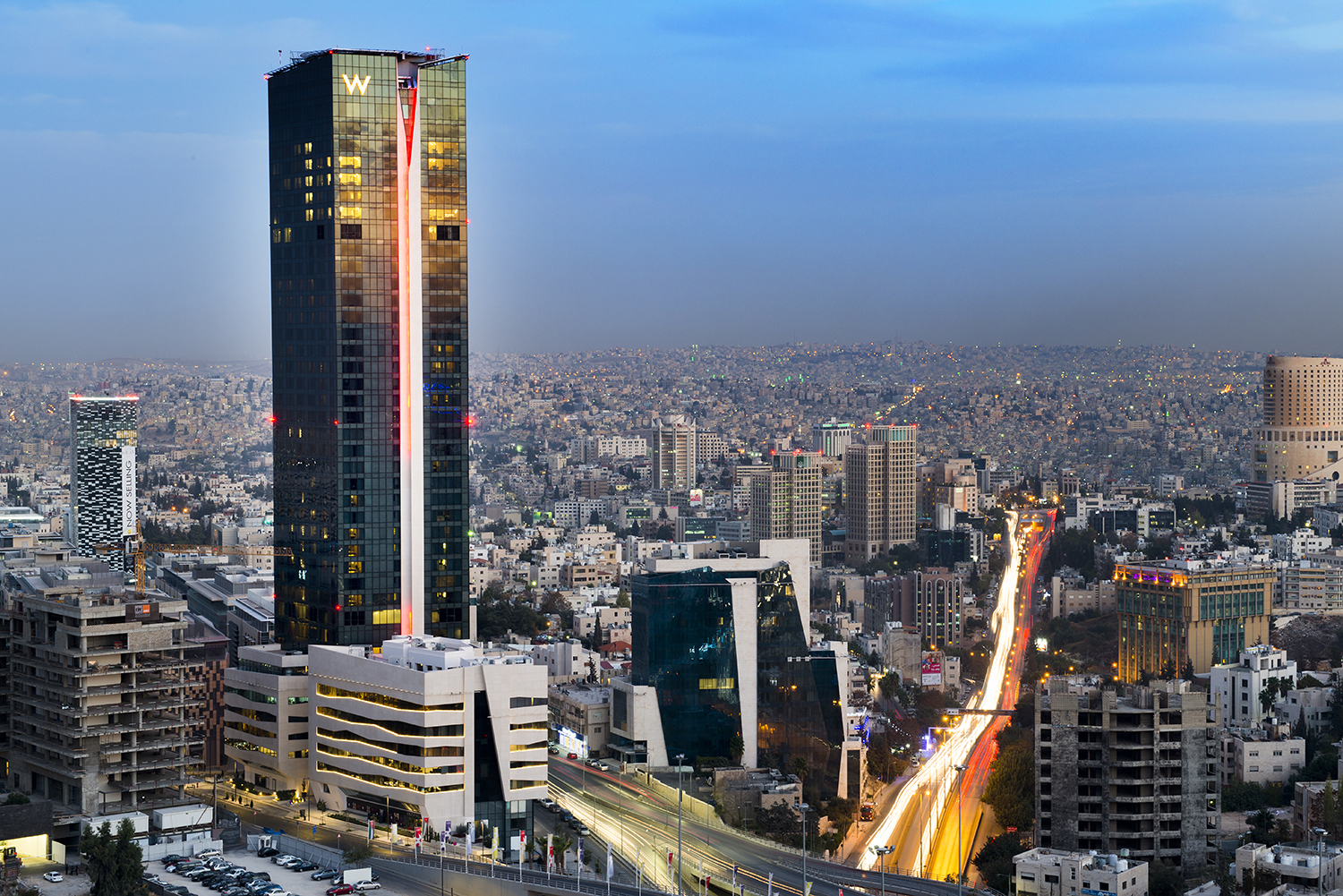GENERAL INFORMATION
I Introduction
Jordan, Hashemite Kingdom of (Arabic Al Mamlakah al Urdunniyah al Hashimiyah), kingdom in southwestern Asia, bounded on the north by Syria, on the east by Iraq and Saudi Arabia, on the south by Saudi Arabia and the Gulf of Aqaba, and on the west by Israel and the West Bank, an area previously held by Jordan that has been occupied by Israel since 1967. The area of Jordan is 89,556 sq km (34,578 sq mi). Amman is the capital and largest city of Jordan.
II Land and Resources
The principal geographical feature of Jordan is an arid plateau that thrusts abruptly upward on the eastern shores of the Jordan River and the Dead Sea, reaching a height of about 610 to 915 m (about 2,000 to 3,000 ft), then sloping gently downward toward the Syrian Desert in the extreme east of the country.
The Jordan Valley is in the deep depression of the Great Rift Valley, which is 209 m (686 ft) below sea level in the area of the Sea of Galilee (Lake Tiberias) and 408 m (1,340 ft) below sea level at the Dead Sea, the world’s lowest point. Deep canyons and mountainous outcroppings with elevations of approximately 1,500 m (approximately 4,900 ft) and more characterize the Arabian Plateau in the southern portion of the country. The Jordan River, forming the country’s border with Israel and the West Bank, is the heart of the country’s drainage system.
A. Climate
The climate of Jordan is marked by sharp seasonal variations in both temperature and precipitation. Temperatures below freezing are not unknown in January, the coldest month, but the average winter temperature is above 7° C (45° F). In the Jordan Valley summer temperatures may reach 49° C (120° F) in August, the hottest month, but the average summer temperature in Amman is 26° C (78° F). Precipitation is confined largely to the winter season and ranges from about 660 mm (about 26 in) in the northwestern corner to less than 127 mm (less than 5 in) in the extreme east.
B. Vegetation and Animal Life
Because much of Jordan consists of desert and steppe, plant life is not abundant. Grassland and wooded areas are found in the Jabal Ajlun district between Amman and the Syrian border. In these regions the trees include willow, oleander and tamarisk along the lower Jordan River valley and also ilex, olive, Aleppo pine, and palm. Wildlife includes the hyena, hyrax, gazelle, ibex, fox, partridge, mongoose, and mole rat; birds are also well-represented.
C. Mineral Resources
Except for potash and phosphate deposits, Jordan has few known mineral resources that are large enough for commercial exploitation.
III Population
The population of Jordan is almost entirely Arab. The only sizable racial minorities in the country are the Circassians and the Armenians; each group accounts for less than 1 percent of the population. Jordan is 79 percent urban; nomads and seminomads make up perhaps 5 percent of the population.
A. Population Characteristics
The population of Jordan (2003 estimate), is 5,460,265, yielding an average population density of 61 persons per sq km (158 per sq mi).
B. Principal Cities
Amman, the capital and largest city of Jordan, grew in population from a census estimate of 321,000 in 1966 to nearly 648,000 at the 1979 census, largely because of the influx of refugees from the West Bank area in the wake of the Six-Day War with Israel in 1967; in 2000 the city had an estimated 1.1 million inhabitants. Other important cities include Az Zarqa’ (population, 2000 estimate, 428,623) and Irbid (247,275). Al ‘Aqabah, the only seaport, had an estimated population of 41,900 in 1989.
C. Religion and Language
The great majority of the Jordanian people are Sunni Muslims. Shia Muslims form a small minority. Christians, about one-third of whom belong to the Greek Orthodox Church, make up about 4 percent of the population. Islam is the state religion and Arabic the official language
D. Education
Jordan has made significant strides in education in recent decades, despite the influx of hundreds of thousands of refugees and the very large share of the national budget assigned to the armed forces. Public education is free and compulsory between the ages of 6 and 15. At the secondary level, about 80 percent of the male children and 78 percent of the female children go to school. Some 91 percent of the Jordanian population age 15 or older was literate in 2003.
In the 1998–1999 school year 706,198 pupils attended elementary schools in Jordan, another 579,400 students attended secondary schools, and 142,200 students were enrolled in institutions of higher education.
The country has two major universities: the University of Jordan (1962) in Amman, and Yarmouk University (1976), in Irbid. Other facilities for higher education in Jordan include the Statistical Training Center and institutes for the study of agriculture, banking, social work, and public administration.
E. Libraries and Museums
The major libraries of Jordan are the Greater Amman Public Library, the University of Jordan Library, and the Scientific and Technical Information Center, all in Amman. Major museums housing historical, religious, and archaeological treasures are the Jordan Archaeological Museum, the Mosaic Gallery, and the Folklore Museum, all in Amman.
IV Economy
Underdeveloped industrially, poor in natural resources, and largely too arid for agriculture, Jordan is not economically self-supporting and must depend heavily on foreign aid, primarily from petroleum-rich Arab countries. Further burdens were placed on the economy after the 1967 Israeli occupation of the West Bank, which contained nearly half of Jordan’s agricultural land, and by the subsequent influx of unemployed refugees. In the late 1980s Jordan’s economy became increasingly dependent on the overland transport of goods from the port of Al‘ Aqabah to Iraq and on remittances from Jordanian workers employed in the Persian Gulf states. Both these sources of revenue were jeopardized by Iraq’s invasion of Kuwait in August 1990; the Persian Gulf War of 1991 dealt a serious blow to the Jordanian economy. In 2000 Jordan’s budget revenues were $2.1 billion and its expenditures were $2.6 billion.
A. Agriculture
The proportion of the labor force engaged in agriculture declined from 37 percent to 6 percent between 1965 and 1993. Only 3 percent of the land is cultivated, and only a small percentage of the cultivated area is irrigated. With so much of Jordan’s agriculture dependent on rainfall, annual production figures fluctuate widely. Wheat and barley are the major grain crops, but production is not sufficient to meet the needs of the country. Cereal production in 2002 was 152,350 metric tons. Some fruit crops, primarily citrus, olives, almonds, figs, grapes, and apricots, and such vegetables as cucumbers and tomatoes are grown for export. Even in the best agricultural years, food imports exceed food exports. In 2002 sheep, the most important livestock animal, totaled 1.9 million; cattle, some 67,000; and goats, about 550,000. Poultry in 2002 totaled 24 million. The West Bank accounted for an estimated 20 to 25 percent of the grain, 70 percent of the fruit, and 40 percent of the vegetable produce of Jordan before the 1967 war with Israel.
B. Mining
Mining operations in Jordan produced 5.8 million metric tons of phosphate rock in 2001. The nation also mines significant amounts of potash salts. Both minerals are used in the production of fertilizer.
C. Manufacturing
Jordan lost about one-fifth of its industrial production as a result of the Israeli occupation of the West Bank in 1967. Since then, the Jordanian government has encouraged the expansion of industry through fiscal concessions and high protective tariffs. In 1993 manufacturing, construction, and mining employed 25 percent of the country’s labor force.
D. Energy
Jordan generates 99.4 percent of its electricity in thermal installations using imported petroleum. In 2001 the country’s output was 7.1 billion kilowatt-hours.
E. Currency and Banking
Since 1950 Jordan has issued its own currency, the Jordanian dinar (0.71 dinar equals U.S.$1,4; fixed average), which is divided into 1,000 fils. The Central Bank of Jordan, which was founded in 1964, is the country’s bank of issue.
F. Foreign Trade
The principal exports of Jordan, apart from agricultural produce shipped to neighboring countries, are phosphates, potash, fertilizers, foodstuffs, and pharmaceuticals. The principal imports are crude petroleum, food, transport equipment, machinery, chemicals, iron and steel, and electrical and electronic items. Leading purchasers of Jordan’s exports are Iraq, India, Saudi Arabia, the United Arab Emirates, the United Kingdom, Syria, and Indonesia; chief sources for imports are Iraq, the United States, Italy, Germany, France, Turkey, Syria, and Saudi Arabia. In 2001 the total value of Jordanian imports was $4.9 billion, and the total value of exports was $1.9 billion. Tourism is an important source of foreign exchange revenue. In 2001, 1.5 million tourists visited Jordan, yielding $700 million in income.
G. Transportation and Communications
Jordan has a modern road network of 7,245 km (4,502 mi), nearly all of it paved. All major cities are linked by asphalt roads, and small towns by oiled or dirt roads. In 1997 there were an estimated 50 passenger vehicles for every 1,000 inhabitants. The only rail lines run from the Syrian border through Amman to Ma‘an, where branches run southeast to Saudi Arabia and southwest to the port of Al‘ Aqabah, a total of 293 km (182 mi). The air terminal in Amman is served by Alia-Royal Jordanian Airline and other international airlines.
In 2001 Jordan had in use 127 telephone mainlines, 271 radio receivers, and 119 television sets for every 1,000 inhabitants. Publications include 5 daily newspapers, as well as 20 nondaily newspapers.

 [/vc_column_text][/vc_column][/vc_row]
[/vc_column_text][/vc_column][/vc_row]